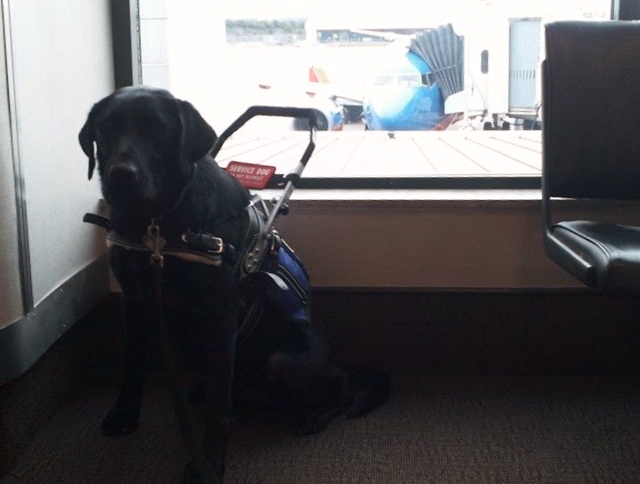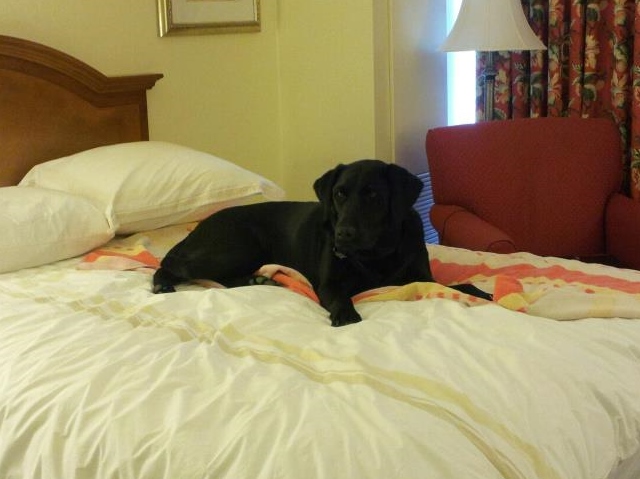Gizmo and I have been partnered for two years, and during that time we’ve done planes, trains, automobiles, and hotels in the course of our travels. I get asked a lot of questions by curious dog lovers as well as new Service Dog (SD) partners. Since we just returned from a working vacation that included flying, a lot of car time, and staying in a B & B, I am primed to tackle this topic.
- Do your homework before booking your trip. Just because the ADA protects the disabled person’s right to have a service dog with them doesn’t mean it’s always easy. Also, the ADA rules are only applicable in the US. If you are traveling outside the US, different rules may apply. Flying with a SD is covered by Air Carrier Access Act, not ADA, and has different guidelines. Take time to read them. I have also found most airlines want to be helpful and have a page on their websites about traveling with service dogs. TSA also has a helpful page on its website. When in doubt, call the airline and ask questions before buying your plane ticket.
- Practice how you will handle security before your trip. We asked friends of ours who Gizmo doesn’t know to help us practice the pat down so we knew Gizmo would stand quietly while the TSA agent checked him. It took awhile for Gizmo to understand this wasn’t play time, and that he had to hold his STAND-STAY. Gizmo’s harness has a lot of metal parts, so we knew that would set off the metal detectors. What works best for us is for Gizmo to be in a SIT-STAY while I go through the metal detector. Once I’m clear, I call him to me. He sets it off as everyone expects, and then we step aside and an agent wands him, pats him down, and goes through his vest pockets. I have heard plenty of horror stories about TSA, but we have been very fortunate each time and had very professional agents, and often a dog lover who volunteered to do Gizmo’s pat down.
- Make sure your SD can handle short easy trips before planning a long hard journey. Just like you start with short car trips around the block and then around town before loading up your dog for a road trip, Gizmo’s first flight was short, and I had an alternate option in mind in case he just couldn’t handle flying. I made sure he was comfortable with local light rail trips before booking an Amtrak vacation. The other advantage of the short practice sessions is it alerts you to potential problems while you have time to come up with a solution.
- What goes in must come out. Most SD partners know their dog’s eating, drinking, and bathroom habits, so planning for this is a bit easier than with most pets. Gizmo eats at the same time every night so that he goes #2 at almost the same time every morning. This is good information to have when scheduling transportation. Many airports now have relief areas for dogs, but I’ve found that they tend to be AstroTurf. I couldn’t find a patch of grass at the last two airports to save ourselves. We have had worse problems at hotels. I have talked to other SD partners whose dogs will not go on AstroTurf. SDs are trained to potty on command, but I encourage you to practice having your dog go on a variety of surfaces: grass, gravel, concrete, mulch, pee pads, and AstroTurf. The pee pads are actually nice because if all else fails, you can spread it on the floor of the restroom, let him go, then pick it up and dispose of it like a baby diaper. Additionally, I cut off his water about twelve hours before a long trip. While in transit I give him a few ice cubes from my drink–he thinks ice cubes are a treat, so it’s a win-win. Gizmo also drinks from a sport-top water bottle, and I can purchase those anywhere.
-
Give your SD a towel or blanket as his permanent “bed.” Most service dogs are crate trained, but due to the requirements of their jobs don’t actually use them. Gizmo has a big beach towel that I can put anywhere and he knows that’s his spot. It works in planes, restaurants, hotels, cars, etc. It is familiar to him, smells like home, keeps lovely white hotel bedding clean, and keeps him clean from the floors. (After having to clean gum out of his fur once, I absolutely prefer the “inconvenience” of carrying Gizmo’s towel with us.)
- Know where you can purchase his food or treats when you arrive. I always have his training treats in my purse, and have not had any trouble traveling with those; however, dog food may be a different issue. Big dogs require lots of food, and you don’t want to weigh down your luggage with it. Also, TSA has a rule about traveling with meat, and one agent made me throw away a bag of dog food. Before traveling, I look up the pet stores at our destination and call to see if they carry his brand and variety of food. Traveling can upset a dog’s stomach, as can changing food, so you certainly don’t want to do both at the same time.
- Be prepared, be calm, and enjoy your trip. The main reason dogs make such excellent partners for those of us with disabilities is because they know our every quirk and sense our emotions. If you are rushed, stressed, or upset your SD will be, too. I truly enjoy traveling, and I am certain that because I am happy Gizmo is happy.
Hopefully these tips will help. Feel free to ask questions or add suggestions in the comment box. Happy traveling!





Leave A Comment